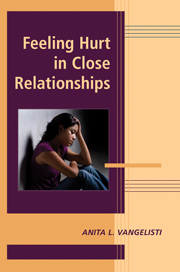Book contents
- Frontmatter
- Contents
- List of Contributors
- Foreword
- PART I INTRODUCTION
- PART II CONCEPTUALIZING HURT
- PART III HURTFUL ACTS
- PART IV HURT IN RELATIONAL CONTEXTS
- 12 Aggression and Victimization in Children's Peer Groups: A Relationship Perspective
- 13 Haven in a Heartless World? Hurt Feelings in the Family
- 14 Hurt Feelings in Adult Friendships
- 15 When Love Hurts: Understanding Hurtful Events in Couple Relationships
- 16 Hurt in Postdivorce Relationships
- PART V HURT IN APPLIED CONTEXTS
- Author Index
- Subject Index
- References
16 - Hurt in Postdivorce Relationships
from PART IV - HURT IN RELATIONAL CONTEXTS
Published online by Cambridge University Press: 04 August 2010
- Frontmatter
- Contents
- List of Contributors
- Foreword
- PART I INTRODUCTION
- PART II CONCEPTUALIZING HURT
- PART III HURTFUL ACTS
- PART IV HURT IN RELATIONAL CONTEXTS
- 12 Aggression and Victimization in Children's Peer Groups: A Relationship Perspective
- 13 Haven in a Heartless World? Hurt Feelings in the Family
- 14 Hurt Feelings in Adult Friendships
- 15 When Love Hurts: Understanding Hurtful Events in Couple Relationships
- 16 Hurt in Postdivorce Relationships
- PART V HURT IN APPLIED CONTEXTS
- Author Index
- Subject Index
- References
Summary
The termination of any valued relationship through which individuals meet their needs for inclusion and affection and in which they have invested tangible and psychological resources is emotionally involving. The loss of a close friend, a dating partner, and even a coworker can evoke strong emotional responses. However, divorce and its emotional aftermath are unique experiences. Not only is the marriage union publicly recognized and officially validated, but its dissolution is likewise publicly recognized and officially recorded. Joint property must be redistributed and living space must be changed for one or both partners. Perhaps most problematic, when children are involved, decisions about custody, visitation, and coparenting must be negotiated. In short, a system of affective, identity-relevant, and structural connections must be explicitly acknowledged and realigned – a process that Emery (Sbarra & Emery, 2006) refers to as “renegotiating relationships” because partners who are also parents can never completely terminate their relationship.
Needless to say, the process of divorce and the subsequent challenges inherent in renegotiating postdivorce relationships involve the experience and expression of complex and often contradictory emotions. Depending on the proximate cause of the divorce (e.g., a critical event such as the discovery of an affair or simply a slow drifting apart), partners and children may experience social emotions such as embarrassment and shame; self-focused emotions such as guilt, sorrow, regret, and fear; or other-focused emotions such as anger and resentment.
- Type
- Chapter
- Information
- Feeling Hurt in Close Relationships , pp. 336 - 356Publisher: Cambridge University PressPrint publication year: 2009
References
- 4
- Cited by



